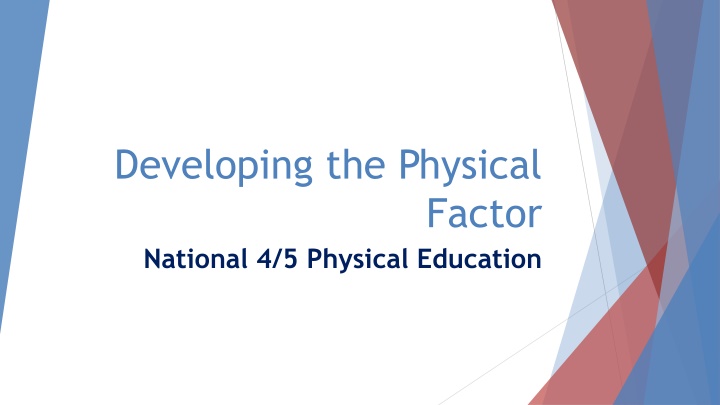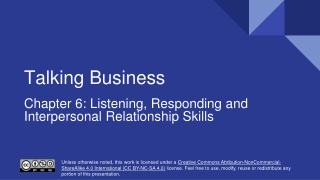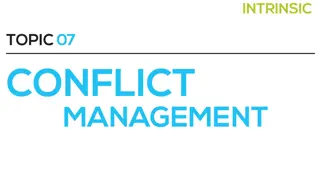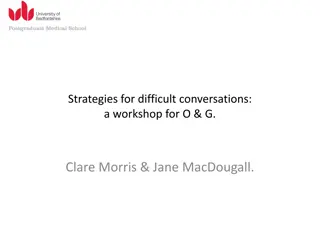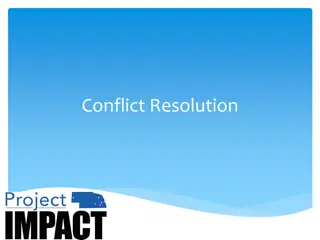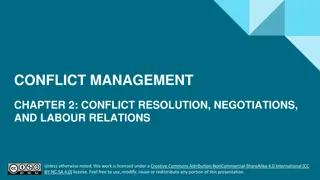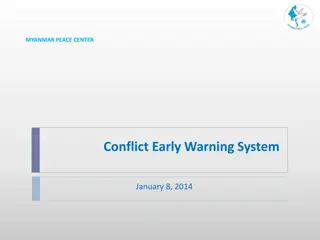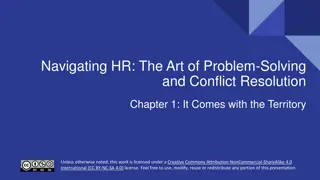Interpersonal Conflict: Principles and Communication
Interpersonal conflict is a natural outcome of human interaction. This article discusses the principles of conflict resolution, the importance of interpersonal conflict in stimulating productivity and resolving issues, and the major elements of effective communication in conflict situations. Learn how to manage conflict positively through understanding and applying key principles.
Uploaded on Apr 04, 2025 | 1 Views
Download Presentation

Please find below an Image/Link to download the presentation.
The content on the website is provided AS IS for your information and personal use only. It may not be sold, licensed, or shared on other websites without obtaining consent from the author.If you encounter any issues during the download, it is possible that the publisher has removed the file from their server.
You are allowed to download the files provided on this website for personal or commercial use, subject to the condition that they are used lawfully. All files are the property of their respective owners.
The content on the website is provided AS IS for your information and personal use only. It may not be sold, licensed, or shared on other websites without obtaining consent from the author.
E N D
Presentation Transcript
Developing the Physical Factor National 4/5 Physical Education
PHYSICAL FACTOR The Impact of the physical factor is arguably the most noticeable impact on a performance as it can be easily seen in a performance The Physical Factor breaks down into 3 different categories Physical Fitness Physical Skill Physical Tactics
PHYSICAL fitness The main features of Physical Fitness are: CRE, Speed, Agility, Strength, Flexibility, Power and Local Muscular Endurance (LME) We are going to discuss the IMPACT these features on your performance We are also going to discuss how to gather information on each of these features and development approaches (The Cycle of Analysis)
Cycle of Analysis The method(s) you use to identify factors (which are strengths and weaknesses) in your performance is the first stage of the cycle of analysis. Once you collect this information you can plan a programme to try and improve upon your weaknesses. To develop your performance effectively you must understand and follow the Cycle of Analysis The Cycle of Analysis is used to develop all of FOUR factors (Mental, Emotional, Social and Physical) but for this section we are going to solely focus on the Physical Factor
Cycle of Analysis Observe Performance and Collect Data Carry out a training programme and monitor your progress Collect Results and Identify Strengths and Development Needs Plan a training programme which focuses on improving your development need
Principles of Training Another principle you must consider when starting a training programme is The Principles of Training . This can be remembered by the acronym SPORT Specific Is your training programme specific to what you want to improve? Progressive Are you advancing your training to match your level of progress Overload How are you going to make it more difficult Reversibility If I miss or stop training how much of my level of fitness will I lose Tedium How can I keep my training interesting so that I remain motivated
PHYSICAL fitness - CRE CRE This is the ability of your heart and lungs to deliver oxygenated blood to your working muscles. A strong and healthy heart can deliver more oxygenated blood around the body with each beat. This allows your muscles to receive the oxygen that they need to continue to work. How do you think having a good/ poor level of CRE can either positively or negatively impact on your performance? Explain by giving an example in an activity and how it can effect you re the overall game/match
PHYSICAL fitness - CRE What methods of gathering information can we use to collect information on CRE? Multi Stage Fitness Test (Bleep test) 12 Min Cooper Run Both these tests are standardised tests. This means that you set them up under the same conditions and the same way each time. You will also have a table of norms which you will be able to compare you score against.
PHYSICAL fitness - CRE There are a number of different training approaches for developing CRE. Feature Method of Gathering Data Multi Stage Fitness Test 12 Min Couper Run Development Approach CRE FARTLEK Training Interval Training Continuous Training For further details of each of the methods of training refer to the Physical Booklet on the PE Blog under Physical Fitness.
PHYSICAL Fitness Speed/ Agility Speed is how quickly you can travel between two points This might be used to generated power when running towards a trampette, to strike a ball or outpacing an opponent Agility however is how quickly you can change direction This might be used to get yourself back into position after playing a badminton shot, losing a marker at a corner or being able to change direction with the ball to mislead an opponent in basketball
PHYSICAL Fitness Speed/ Agility Methods of Gathering Data: Standardised Tests Feature Method of Gathering Data Sprint Test (10m) Illinois Agility Test Development Approach Speed Agility Sprint Training Speed Agility Quickness Training (SAQ) Plyometric Training Agility T Test
PHYSICAL Fitness Strength/ Power Strength is the maximum force a group of muscles exert in one movement This could be used to hold a balance, strength to hold off an opponent when in possession or strength to push against an opponent in a scrum Power is the combination of strength and speed. It is an explosive movement which happens quickly with a lot of force This could be striking a shuttle or ball, power in your legs when jumping or your arms when punching during boxing/ MMA
PHYSICAL Fitness Strength/ Power Again the main methods of gathering data for these two features are Standardised tests. Below is a list of different standardised test and development approaches for Strength and Power Feature Method of Gathering Data Development Approach Resistance Training Strength One Rep Max Tests Grip Dynamometer Standing Long Jump Standing Vertical Jump Power Plyometric Training Power Circuits
PHYSICAL Fitness Flexibility Flexibility is the range of movement a body part has around a joint This could allow you stretch to reach a shuttle/ball keeping yourself in a rally, allow to you get into a more complex gymnastics position to score higher difficulty points or allow to have a greater range of movement to swing your leg back further to generate more power when striking a ball
PHYSICAL Fitness Flexibility Again standardised test are mainly used to gather information on this feature. Below is a table showing both development approaches and methods of gathering data Feature Method of Gathering Data Sit and Reach Test The Rope Test Development Approach Flexibility Yoga Static Stretching Pilates
PHYSICAL Fitness Local Muscular Endurance (LME) Local Muscular Endurance is the ability of a muscles or group of muscles to work continuously during exercise This is beneficial for sports were you require to perform the same action repeatedly such as badminton, volleyball, basketball etc. This will allow you to perform the same action over and over without tiring
PHYSICAL Fitness Local Muscular Endurance (LME) The table below shows the standardised tests and development approaches Feature Method of Gathering Data One Min Press Up Test One Min Sit Up Test Development Approach LME Circuit Training
